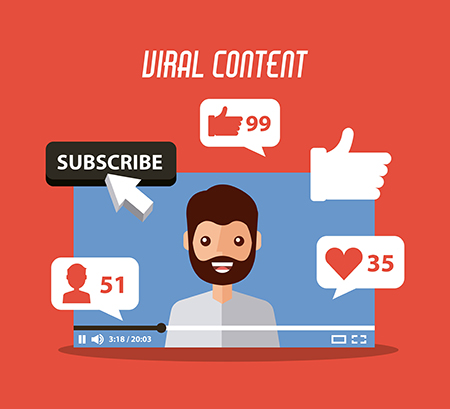Five content marketing trends to watch in 2020
By Pranav Vadehra published on July 8, 2020
B2B content marketing continues to evolve at a rapid pace, becoming more sophisticated than ever before, reflecting the growing significance of content marketing for B2B marketers. A B2B buyer has already completed 76% of the buying journey before ever engaging with a sales representative (Source: Sirius Decisions). This makes it imperative for a brand to make sure that its content reaches and influences the buyer at a stage where the experience of the brand is most critical.
Content marketers have a more extensive selection of tools than ever before to elevate the content experience. In this post, we take a look at five key trends that B2B brands should leverage in 2020 to drive their content marketing success. These include
- Video content
- Experiential content platforms
- User-generated content
- Content collaboration and scaling
- Data sophistication in content marketing
In each of the trending areas, we have listed the most innovative products available to content marketers in 2020.
Video Content
Marketing via video is without doubt, the best way to reach people today, as people continue to spend more and more daily minutes watching videos. Statistics show that the average user will spend 88% more time on a website with video content and video marketers get 66% more qualified leads per year (Source: Optinmonster).
Longform Video is in: The assumption that marketing videos should last no more than 30 seconds to one minute is also being turned on its head. The rise of long-form video content is one of the major changes we expect to see in 2020. Emotive, long-form video content gives brands the opportunity to connect with people through storytelling that has a human emotional appeal.
YouTube for B2B marketers: In 2020, we think YouTube could be the platform where businesses thrive because YouTube is still a relatively untapped channel in B2B marketing. Whether it is Instagram with IGTV or TikTok or Facebook Watch, social media is over-saturated with videos and an expensive proposition for B2B advertisers. YouTube video ads have much better ROI potential for business brands – as long as brands produce quality video content.
Video Production for all: B2B marketers using video prominently in their content strategy are moving away from a ‘one size fits all’ approach to video and creating bespoke content based on audience, platform, data, and insights. Video creation platforms designed for B2B companies to produce better videos are packed with a range of advanced features in 2020.
Video production is not nearly as daunting for B2B companies as it was a few years back. The videos produced are cinematic and memorable, and you don’t need to spend on a professional production crew or agency to jumpstart your video marketing efforts.
Video Content Marketing Products: The video content marketing segment is brimming with products for creating and publishing video content online – from simple template-based free video-makers to AI-based platforms that use client data to generate video. From mobile-centric platforms to collaborative production and post-production suites, and from hosting & distribution to monetization, there are video marketing solutions and services to fit every size and shape of business.
- Magisto is an AI-powered end-to-end video maker that helps you transform videos into polished movies.
- Frame.io is an online platform for video post-production collaboration.
- Rocketium is a platform that quickly turns any image or collection of images and videos into Buzzfeed-like videos.
- Videolicious provides mobile video creation solutions for creating professional-quality videos for business filmed on mobile devices.
- Powtoon is a video creation platform that enables anyone to create professional-looking animated videos and presentations in minutes, without any design or technical skills.
- Brightcove is one of the largest online video platform providers used to publish and distribute video online for video on demand and live streaming.
- TouchCast offers a combination of live broadcast and interactive video with features such as background removal, comments moderation, interaction analytics
- TwentyThree is a video marketing platform allowing companies to host, manage, optimize, and analyze their video campaigns; including integrating video data into existing tech stacks.
- MovingImage provides an enterprise-class platform designed for secure video streaming, hosting, and video management that optimizes video workflows across large organizations.
- Lightstream provides live streaming creative tools and technology for content creators on Twitch, Mixer, YouTube, Facebook Live, and other major social streaming platforms.
Experiential Content Platforms
In 2020 making your B2B content stand out is harder than ever. It means building personalized and relevant content experiences for every single customer no matter who and where they are. Today’s audience is used to publishers who can tell immersive and beautifully crafted digital stories in an engaging and visual way – and they expect the same from business brands.
B2B marketers and designers are looking for new ways to create rich digital experiences quickly at scale without any coding or development.
Experiential content is digital content designed for the creation of immersive experiences for its consumers – through a combination of interactive tools, animations, embedded media, and storytelling features.
B2B marketers are turning towards solutions that help them create immersive digital stories that will get the brand noticed among the glut of B2B content available to their audience. We are seeing a new breed of experiential content creation products emerge – tools that allow marketing teams to rapidly create and publish immersive and interactive experiences from multiple sources, and publish across platforms and formats.
Experiential content creation platforms for B2B marketing are available today which let companies build personalized interactive content – like quizzes, calculators, assessments, recommendations, polls, and more. Content experience platforms also aggregate content across formats so marketers can create and optimize tailored content experiences for every stage of the buyer journey.
AI-powered storytelling techniques are gaining traction while visually stunning content is attracting viewers in the form of interactive infographics, animated landing pages, and presentations. Such interactive content allows marketers to leverage their interactive brand and create opportunities to drive appealing and relevant online experiences.
- Wirewax is a video platform that allows you to add interactive elements like clickable hotspots or tags to any moving object in your video.
- Ion Interactive is martech’s chief evangelist Scott Brinker’s company. Their interactive content platform helps create data-driven experiences without tech-savvy resources or developer code.
- HapYak can help you create interactive videos with remarks, insights, opinions, and personality.
- Rapt Media is a creative platform for companies who want to use interactive videos with branching narratives and flexible visual editor.
- Genially is a SaaS tool that lets you quickly create interactive images, presentations, infographics, maps and more
- Ceros is an experiential content creation platform that empowers marketers and designers to create engaging, interactive, and immersive content experiences.
- Zembula‘s interactive solution uses interactive reveal experiences to increase engagement on websites and emails.
- ThingLink is one of the leading providers of visual media interaction tools to create interactive images, videos, and 360°/VR media
- Apester offers creative tools for interactive storytelling, quizzes, surveys, personality tests, and video polls.
- Mapme lets you create interactive maps designed to display multimedia content such as photos, videos, and 360 tours.
User-Generated Content
Social platforms have made the phenomenon of user-generated content widely prevalent for consumer brands. The digital world is full of success stories involving companies who have empowered the voice of the customer and turned Advocates into Influencers. Apple leveraged the power of its user community with its famous “Shot on iPhone” ads helping to drive home the message that their phones can shoot fantastic quality videos.
Voice of the Customer: B2B brands too can explore ways to leverage the power of outside content created on behalf of the company by fans and super users. User-generated content (UGC) puts your customer front and center and shows the world that your product or service is making people happy.
Using UGC really gives you your brand authenticity because people trust their social groups more than they trust marketers. Customers are your best content creators. Generating and scaling quality content from users is a challenge not many brands have mastered but those who take on the challenge can get fantastic results.
User Ratings: In 2020, B2B marketers have the tools to move into a more advanced phase of UGC deployment, adding user ratings into their UGC to allow for pieces of content to be scored. This helps to build up a reliable group of community influencers that companies can leverage in their UGC programs.
User generated content solutions on the market offer various ways to leverage your user community for content including – review and rating engines, social media aggregators, advocate management and discovery, rights management, curation tools, visual tools, and UGC content distribution.
- Stackla’s Organic Influencers product allows a company to build a proactive UGC strategy to discover, manage and reward advocates, distribute creative briefs and put your library of right-approved UGC to work for your brand across all your marketing channels.
- TurnTo provides the next generation of customer content solutions to top merchants and brands. They offer a suite of 4 innovative products for Ratings & Reviews, Community Q&A, Visual Reviews, and Checkout Comments
- PowerReviews helps brands and retailers increase sales by empowering the voice of the customer. They offer a full UGC suite including content acceleration and analytics.
- Taggbox is a UGC platform with solutions to discover curate and display user-generated content across all marketing touchpoints.
- Wyng allows brands to build micro experiences to collect the exact user data they want and activate the data to personalize recommendations, content and offers.
- ExpertVoice connects its community of more than 1 million vetted experts to help brands drive more sales with the help of expert recommendations.
- Ignite’s ResponseTek includes solutions for Voice of the Customer, Voice of the Employee, and Listening Lab. They have also acquired Chute – a solution that helps brands identify and secure user-generated content with automated workflows and image recognition.
- FanKave is a fully managed and real-time social media aggregation, synthesization, and visualization platform. They help brands to increase engagement and brand value with visualization of the synthesized content, displayed through a variety of digital signage experiences.
- New Spark Media is a digital workflow solution for brands and media companies to securely gather, manage, publish, and report on user/employee-generated content at scale.
Content Collaboration and Scaling
As companies grow, they find the process of publishing content gets more and more complex. Planning, organizing, and managing content across multiple systems with hundreds of stakeholders are chaotic and time-consuming tasks.
A significant trend in 2020 will be more B2B companies turning to content management platforms that can help content teams collaborate across boundaries and manage their operations smoothly without compromising on security.
For large enterprises and media companies who publish at a much higher frequency, deploying collaboration systems helps them organize operations and produce effective content, at scale.
Remote Collaboration is the New Normal: Successful content marketing is dependent on marketing teams having a unified workflow even if they are working from different locations. As remote collaboration becomes the new normal, solutions to help content teams navigate a new remote workflow are on every B2B CMO’s mind.
B2B Marketing teams need to reinvent how they scale operations to maintain collaboration and productivity in a remote-first environment. The shift towards content collaboration platforms is driven by the need to integrate a variety of processes and tools for digital asset management, file storage, co-creation, publishing, security management, and version control.
More and more companies are ditching the traditional word processing and content creation tools for new-age collaborative tools that streamline these workflows and add collaborative features to the mix, and facilitate B2B sales and marketing processes that source content from disparate systems and sources.
Agile Content Creation: Productivity-centric functionality built into these systems can help remote marketing teams with shared visibility into content workflows, facilitate real-time collaboration and ideation, and drive agile processes in content production and management.
- Bit.ai is a new age cloud-based document collaboration and content collaboration platform. Bit helps teams collaborate on interactive documents, store digital assets, and track their documents and add any type of content from anywhere.
- Alfresco is an Enterprise Document Management System for an efficient workflow. Alfresco provides all the necessary features for creating, editing, and storing documents as well as features like version-control, cloud storage, project wikis, task lists, and activity feeds and a mobile app to allow users to view and share documents on the fly, making it truly flexible and accessible.
- Widen has a suite of apps designed for enterprise content management including asset management, product enrichment, portals, web to print, and workflow solutions.
- Samepage combines team chat, video conferencing, screen sharing, task management, file sharing, and real-time team document collaboration in a single cloud-based collaborative workspace.
- Wipster is a cloud-based platform for reviewing, approving, and collaborating on content production projects.
- Wimi is an all-in-one collaboration tool for businesses. Wimi includes dedicated workspaces: file sharing & drive, task management, calendar sharing, instant messaging, and video conferencing.
- Zoho Docs is a comprehensive online document management system used for creating, storing, sharing and collaborating on documents of almost any format.
- DocSend‘s link-based system makes it easy to set security preferences for each stakeholder, receive notifications each time someone views your file, analyze content performance, and create lightweight virtual deal rooms.
- Huddle is a secure document collaboration solution for enterprise and government organizations to collaborate and co-edit documents, control file versions, collaborate with clients, and organize team tasks along with built-in approval workflow.
- ThoughtFarmer is designed to streamline internal communication, facilitate knowledge management, and encourage collaboration across geographical distances.
Content Creation Marketplaces: the growing need to produce content at a higher frequency and cadence for multiple platforms and target groups is leading to managed content creation marketplaces becoming an attractive value proposition for B2B marketers.
Managed content creation services allow B2B companies to engage top tier creative talent who understand both the subject matter and audience while allowing B2B marketing teams to retain creative control over brand voice and content rights.
Services like the Syptus Content Hub provide managed access to a roster of writers, creatives, and subject matter experts who provide a range of content creation services to help build, nurture, and grow your target audience.
Data sophistication in content marketing
The final trend for 2020 we predict is a huge shift towards data-driven content marketing practices. As B2B marketers realize the futility of chasing elevated keyword rankings as the ultimate business outcome, there will be a greater push for leveraging intent data into the full content marketing lifecycle. Getting found in engines simply increases the probability of increased traffic and does not necessarily improve conversion rates.
Full-stack content marketing takes a lot more effort. Some areas where data can shine include:
- Building cross-format inventories of content marketing collateral: Marketing collateral is not just your company blog. It includes multiple content formats like PDFs, Presentation decks, Webinars, Videos, Podcasts, Email, and more. Beyond just churning out new content B2B marketers will shift focus to building centralized repository and proper visibility into existing assets to open up new opportunities to leverage content.
- Data-driven content audits: A well-executed content audit can deliver big insights into content marketing strategy and tells you how the content is performing over time. Only when content marketers can objectively score their content assets can they develop a concrete content agenda that is driven by objectivity. B2B marketing teams must return to their content and ensure it is fresh and continues to perform. In 2020, B2B content marketers must be able to conduct periodic data-driven audits based on factors like keyword usage, on-page SEO, freshness, age, search engine visibility, engagement metrics, and more such parameters.
- Holistic content scoring: Content scoring can no longer be simply using on-page technical checks as a single parameter for gauging quality. Internal linking, reviews and ratings, keyword usage, strategic alignment with content strategy, search engine performance, analytics engagement, and conversion data are all dimensions that must be included in order to make a holistic assessment of content performance. Technical sophistication that goes beyond checking HTML tags will drive this key capability.
Content Marketing is changing
These five content marketing trends are helping B2B marketers up their content game in 2020. We would love to hear which of these 2020 content marketing trends are the most relevant to your business, and which other trends and products you think should be on this list.






